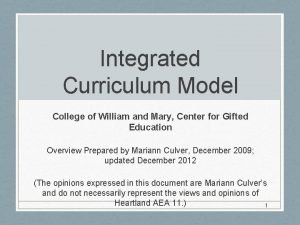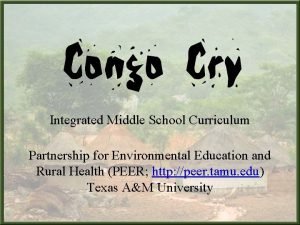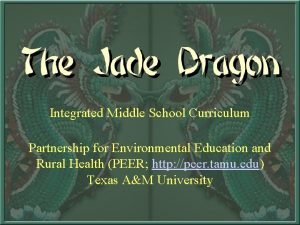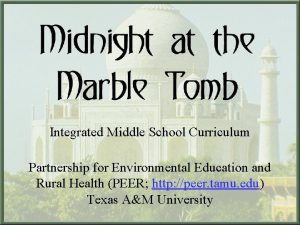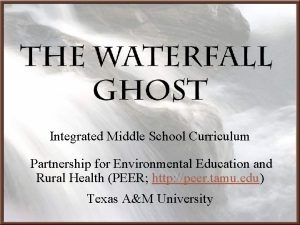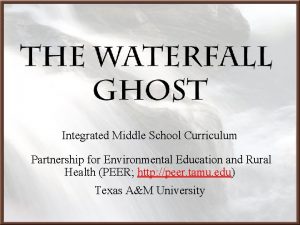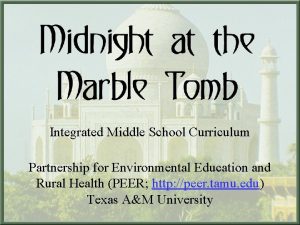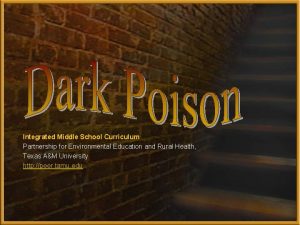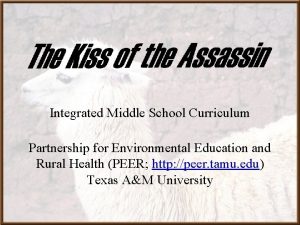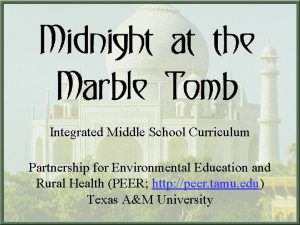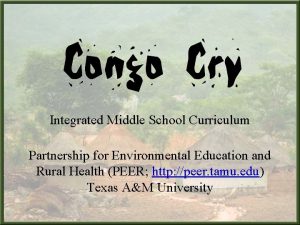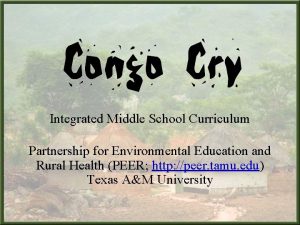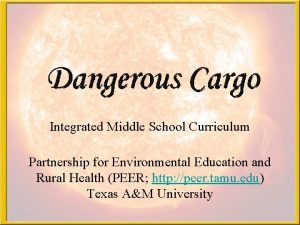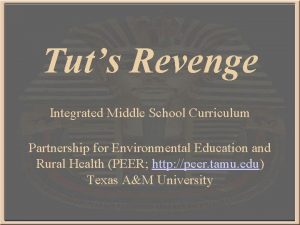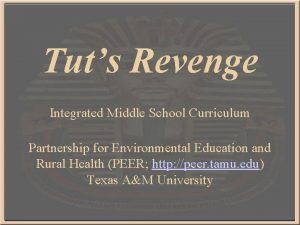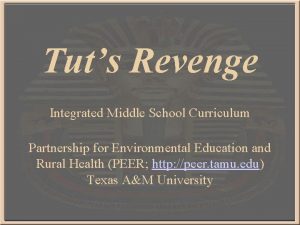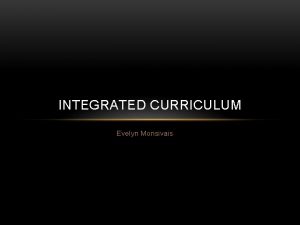TEXAS Integrated Middle School Curriculum Partnership for Environmental













































































- Slides: 77

TEXAS Integrated Middle School Curriculum Partnership for Environmental Education and Rural Health (PEER; http: //peer. tamu. edu) Texas A&M University

Primary Authors: Jon Hunter Bill Klemm Deborah Kochevar Jim Kracht Based on a story by Marguerite Swilling Production of the Partnership for Environmental Education and Rural Health funded by NIEHS, Larry Johnson, PI

Mr. or Ms. Smith’s class TEXAS Your Middle School

Investigator Challenge Quiz • Read the “Texas: 1867” story carefully. • Take the Investigator’s Challenge Quiz to determine how carefully you read the story. • After you complete the quiz and see your score, review each question. • Find the part of the story that provides the correct answer to the question. • Underline or highlight the important details you find. TX-1. 0

What was Texas like in 1867? • Life in Texas in 1867 was very different from the Texas we live in today. • If you were to draw a picture of Texas in 1867, what would it look like? TX-2. 0

Transportation • People traveled from city to city by stagecoach. This means of transportation was difficult and often dangerous. The roads were dirt trails that turned to mud after rainstorms. Robbers sometimes attacked stagecoaches in the wilderness. • Imagine that you are traveling by stagecoach to another city. What types of supplies would you want to take with you? TX-3. 0

Transportation TX-4. 0 • Riverboats were used to carry goods and supplies up and down the rivers in Texas. • These big boats could only travel through deep water and many could not go to towns located in the interior of Texas. • Can you think of any advantages of sending supplies by riverboat instead of by stagecoach?

Transportation • Starting in the 1850’s, railways were being constructed in Texas. • By 1867, railroads were being constructed across much of the eastern part of the state. • Trains could travel much faster than stagecoaches and were more dependable. • What would be the benefit of having a faster means of transportation? TX-5. 0

Comparing 1867 to Today • Galveston and San Antonio are about 247 miles apart. • In 1867, traveling by stagecoach from Galveston to San Antonio could take many days. • Today, we travel much faster than people in 1867. If you were to travel 60 miles per hour, approximately how many hours would it take you to travel from Galveston to San Antonio? TX-6. 0

Economy • Many of the early Texans were farmers. Some had family farms and others had large plantations. • The most popular crop was cotton. Much of the cotton was sold to the northern states and used to make cloth. • Farmers also grew sugarcane, corn, sweet potatoes, and wheat. • How do you think advances in transportation affected the Texas economy? TX-7. 0

Economy • Between 1850 and 1860, cattle ranching became very popular. • Cattle were a good source of: – Food (beef). – Hides used for shoes and clothing. – Tallow used to make soap and candles. • Some ranchers would drive or ship their cattle to other states to auction them off to the highest bidder. TX-8. 0

Economy • Most industries in Texas were related to agriculture. Courtesy of Sandy Spring Museum • Many people worked to process the agricultural products grown in Texas. – Cotton gins separated the fibers of cotton from the seed. – Gristmills were used to grind grain into flour. Courtesy of Sandy Spring Museum TX-9. 0

Communication • Telephones and email were unheard of in 1867. To communicate, people either had to send letters or use the telegraph. • Letters were delivered by a rider on a horse. It could take days to send a message to someone in another city. TX-10. 0

Communication • The telegraph, invented in 1837, allowed people to communicate over long distances in a very short amount of time. Coded signals could be sent over wires connecting cities and towns across the country. • The telegraph lines in Texas connected many cities, including Galveston and Houston. TX-11. 0

People Living in Texas • According to the Texas Census records, 604, 215 people were living in Texas in 1860. • There were 182, 566 slaves and 421, 649 others, excluding American Indians. • During the Civil War and the years following, there was very little immigration to Texas. TX-12. 0

Life on the Frontier • American Indians lived in Texas long before Europeans or Anglo-Americans came. • Conflicts arose when settlers arrived; life became very dangerous. • The federal government set up forts on the frontier. • The soldiers at these forts tried to prevent conflict between the American Indians and the settlers and travelers in the area. TX-13. 0

Cities in 1867 • In 1867, cities were different from the cities we think of today. • Some of the major cities of 1867 included Galveston, San Antonio, Houston, Austin and Marshall. TX-14. 0

Cities in 1867 • Today, Houston is one of the largest cities in the United States. In 1867 it was the third largest city in Texas and just beginning to grow. • In 1860, the population in Harris County (Houston) was 4, 845. In 2000, the population in Harris County (Houston) was 3, 400, 578. How much has the population grown since 1860? TX-15. 0 Find out more about percents.

Cities in 1867 • Galveston was the Texas boom town in 1867. It was the most populated city in the state. Ships from around the world stopped at the port of Galveston. • Galveston was connected to Houston by railroad. The first train crossed the railroad bridge in 1860. Waiting for permission • Soon after 1867, San Antonio replaced Galveston as the largest city in Texas. • If you were a farmer or rancher, what would be some of the advantages of living near Galveston? TX-16. 0

Cities in 1867 • In 1867, Texas had a total population of 604, 215. Today, the city of Houston alone has a population of 3, 400, 578. • The total population of Texas in 1867 is what percent of Houston’s present population? • If the population of Houston in 1867 was 4, 845 people, how many times greater is the population of Houston in 2003? TX-17. 0 Find out more information on ratios and percents.

Investigate the Mystery • From the story, what do you see as the basic health problem that Travis and Roman saw on their trip to Independence? • What are the possible causes of this problem? Can you state these in the form of a hypothesis? • What kind of evidence would you need to confirm that your hypothesis is correct? • What predictions could you make if the hypothesis were proven correct? TX-18. 0

Planning a Strategy • What are you trying to find out? • What was reported in the story? • What information do you NOT have? TX-19. 0

Let’s Plan a Strategy 1. What do you hypothesize about the general nature of the sickness? (See science appendix for help. ) 2. What facts would test the hypothesis? 3. If the hypothesis were true, what predictions would it make? Do they fit the story? TX-20. 0

Exploring the Sickness • • TX-21. 0 Who got sick and who did not? What are the signs (symptoms) of sickness? Do all affected people show the same signs? What were these people exposed to that might have caused sickness?

Key Clues Make a list of things in the environment and conditions mentioned in the story that might serve as clues to account for the sickness and its spread. TX-22. 0

What is suggested by so many deaths in 1867? • There must have been some kind of epidemic involving a wide area. Why do we rule out chemical pollution? Old Independence Cemetery Independence, Texas • Some special set of conditions must have set off an epidemic. TX-23. 0

Bats at Sundown • Bats normally do not bite people, so they are not likely to cause the problem here. • But bats are a clue. Do you know why? (Hint: What do bats eat? ) TX-24. 0

Want to see the biggest bat show in Texas? • Go to Austin to the Congress Avenue Bridge over the Colorado River. • At sundown, watch a steady stream of bats pour out from under the bridge for 13 minutes or more. • There are so many bats that they look like a soaring cloud of black lace. TX-25. 0

Gone Batty! • Bats are known to eat between 1, 000 and 3, 000 mosquitoes a night. If there are 950, 000 bats under the Congress Avenue Bridge, what is the largest number of mosquitoes that could be eaten in one night? Permission not granted yet have not emailed either TX-26. 0 Find out more information about unit conversions.

Gone Batty! • The 950, 000 Mexican Free-tail bats that live under the Congress Avenue Bridge have an average weight of 1 ounce. If they are known to eat 30, 000 pounds of insects in one night, what percent of the bats’ body weight do they eat in one night? TX-27. 0 Find out more about percents.

Why do you suppose the “fever” epidemic goes away in the winter? Hint: Think about the cold weather. TX-28. 0

What is the purpose of the camphor rags that Nettie used? She said it was to guard against “swamp gases. ” What clue does this give you? TX-29. 0

What is Black Vomit? What does it signify? • The blackness did not seem to relate to what they ate. • The stomach must be digesting something that is already there, and digestion turns it black. • What is always present near the stomach lining? TX-30. 0

What do you make of the bloodletting treatment? • A common treatment for many illnesses prior to about 1890 was to drain blood from the patient. • Why did they practice bloodletting? • We know that this was a really bad idea! – Blood transports our nutrients, oxygen, and waste products. – White blood cells are a primary defense mechanism. (Click here for more. ) TX-31. 0

Investigating Food • Could the food that the people ate have caused the epidemic? • Why or why not? TX-32. 0

Investigating Water • Could something that the people drank have caused the epidemic? • Why or why not? TX-33. 0

Investigating Skin Contact • Could something that the people touched or that contacted them have caused the sickness? • Why or why not? TX-34. 0

Investigating Air • Could the air contain something that caused the epidemic? • Why or why not? TX-35. 0

Possible Multiple Routes of Exposure • Could any of the hazards get into the body in multiple ways? TX-36. 0

What is your hypothesis? 1. What conditions have to be met to support the hypothesis? 2. What information in the story supports the hypothesis? TX-37. 0

Predictions 1. What would your hypothesis predict? 2. Are any of the predictions fulfilled in the story? TX-38. 0

Reviewing Your Hypothesis • Review your original hypothesis. • Does the evidence support it? • What could have been done to prevent the health problems? TX-39. 0

What was the role of mosquitoes? Summarize the evidence that mosquitoes might be spreading the disease. HOW might mosquitoes spread disease? TX-40. 0

How can we get rid of mosquitoes? • Reduce their breeding grounds (still pools and puddles of water). • Spray them with insecticide. – DDT was very effective, but we banned it because it accumulates in animal fat and makes bird eggs fragile. Click here for more. – Some mosquitoes are becoming resistant to the common insecticides. TX-41. 0

We Could Raise Dragonflies • Dragonflies eat huge numbers of mosquitoes and other insects. • Dragonflies have no harmful effects: – They don't bite. – They don't carry human diseases. – They love to eat mosquitoes, especially their larvae. • The problem is that dragonflies breed in the same stagnant pools of water that mosquitoes do. TX-42. 0

We Could Build Martin Houses • These migratory birds move up to the Northern hemisphere during mosquito season. • They eat enormous numbers of mosquitoes, catching them on the fly. For more about these amazing birds, click here. TX-43. 0

What do you think? Learn about the disease that caused this 1867 epidemic. • Can you think of other diseases or epidemics that we have today in our cities? • What can we do to prevent these diseases? • What does history tell us about diseases and epidemics? TX-44. 0

West Nile Virus: A Modern-day Mosquito-borne Epidemic • This disease first appeared in 1999 in Africa and the Middle East. • It is a virus, related to the infectious encephalitis virus, which causes inflammation of the brain. • Birds are a reservoir of infection – the virus spreads from birds to mosquitoes to animals that mosquitoes bite. Learn more about West Nile Virus. TX-45. 0

Old As Time • When Travis arrived at the cemetery in 1867, he noticed that the oak trees were smaller than those in 2003. • The circumference of one of the oak trees measured 37. 7 cm. • If the annual growth rings of the tree were separated by an average of 1. 5 mm, what is the diameter of the tree in 2003? TX-46. 0

How “oaks” are you? Upon returning to the cemetery in 2003, Travis noticed an oak tree stump that died sometime between 1867 and 2003. Travis knew the volume of the oak was 25, 765 cm 3 and that it had a height of 20 cm. Assuming the stump was a perfect cylinder, how long had the oak survived after 1867? Recall that the oak in 1867 had a diameter of 12 cm and grew 1. 5 mm in radius each year thereafter. TX-47. 0 Find out more information on volume.

The Cross! While in the cemetery, Travis noticed an interesting rusty iron cross that stood 1 meter tall and was 0. 5 meter wide. The base and top of the cross measured 5 cm by 10 cm as did the ends of the cross arms. What is the volume of the cross? TX-48. 0 Learn more on geometry.

On the Road Again! In 1867, stagecoaches traveled at a speed of 7 mph. If traveling by stagecoach, how many days would it have taken Nettie and her family to travel from San Antonio to Galveston, a 247 mile distance? Assume that Nettie’s family only traveled during daylight hours. The stagecoach stopped for 3 hours during the day to rest the horses. The sun rose at about 6 a. m. and set at 7: 30 p. m. (Round up your answer to a full day. ) TX-49. 0 Find out more information about unit conversions.

I’ll Take the Car • If Nettie’s family could have traveled by car at an average speed of 60 mph, how long would their 247 mile journey take? • If you consider the delays in traveling by stagecoach, how many times faster is it to travel by car? (Recall that a stagecoach travels at 7 mph. ) Find out more about conversions and decimals. TX-50. 0

Money Matters In the story, Nettie’s Uncle Joshua offered to give her family $2, 000 worth of gold in 1867. If the value of one dollar increased 2. 2% per year, what would be the value of Uncle Joshua’s offer in 2004? X 2. 2% 1867 TX-51. 0 2004 Learn more about percentages.

Cemetery Layout When Travis arrived at the cemetery, he was standing in a lot of 9 graves surrounded by an old, iron fence. The graves were arranged in a 3 by 3 pattern with all the graves oriented in the same direction. Each gravesite measured 3 feet by 8 feet and was located 2 feet from the next gravesite. A distance of 3 feet separated the plot of graves from the old, iron fence that surrounded it on all four sides. What are the dimensions of the lot and what surface area does it cover? TX-52. 0 Learn more about area calculations.

Stained Glass Panes While Travis and Nettie were sitting in the church, a stained glass window 3 feet above the floor illuminated the floor 5 feet away from the wall. If there was a higher window located 15 feet above the floor, how far from the wall would it begin to illuminate the floor? www. kelvinbaggs. com TX-53. 0 Learn more about area calculations.

Rowdy! When Travis called for Rowdy, his voice echoed off of the hilltop. If it took 4 seconds for the echo to return to Travis, how far was he from the hilltop? Assume that sound travels at a velocity of 330 meters per second. TX-54. 0 Find out more information about unit conversions.

For more fun-filled math questions, click here! TX-55. 0

Vocabulary Challenge • Take the Vocabulary Challenge Quiz to test your knowledge of vocabulary found in the story. TX-56. 0

Unlocking Language • Build your language skills by carefully reading Texas: 1867. • Practice these skills by completing the Unlocking Language activities. TX-56. 1

Connecting with the Story When Travis follows Rowdy into the woods, he is surprised to find a hidden cemetery. Think about a time when you unexpectedly discovered something. It could have been a special place you found somewhere, a lucky coin you spotted on the street, or even an old toy in the back of your closet that you had forgotten. Write a journal entry describing your discovery. TX-57. 0

Compare and Contrast When Travis arrives in the cemetery in the year 1867, he realizes that it looks different from the cemetery he discovered in the present. Write a descriptive paragraph comparing and contrasting the cemetery in 1867 and the cemetery in the present. TX-58. 0

Summarize A summary tells the most important things about a piece of writing. It is much shorter than the original written piece, but it includes the important details or events that have occurred. TX-59. 0

What happens when? • Create a timeline that helps summarize the major events of the story. • Remember to include the names of important characters and the location of the action. • Click here for more information on constructing timelines. TX-60. 0

Summarize the Story • Write a one page summary of the story using your timeline as a guide. • Exchange your summary with a classmate and compare the two summaries. • Did you both list the same events? How did your summaries differ? TX-61. 0

Can you follow the action? Travis ran his fingers across a rough limestone marker that had weathered so badly only the faintest trace of the year remained. 1867. Beside it, another was just the same. A third, identical in shape, stood close beside the other two, completely blank. As Roman tried to lift a fourth marker that had fallen beside the others, Travis stood up to view the stones from another angle. That’s when he saw the fifth plain marker nearly buried beneath the drooping branches of the live oak tree. TX-62. 0

Getting Organized • How is the content of the passage on the previous slide organized? • Does it: Explain a problem? Compare one thing to another? Present a sequence of actions? TX-63. 0

Daily Sequences • Present a sequence of events that often occurs during your day. • Include at least 4 events in your sequence. • Remember to use words that help to logically connect your sentences. What are some of these words? TX-64. 0

Word Pictures • Re-read the first two paragraphs of the story. • Identify three similes within these two paragraphs. • Pick the simile that you like best. • Now draw a picture of what comes to mind when you read the simile you picked. TX-65. 0

Is something bad about to happen? • What literary device is the author using in the passage to the right? • What effect does it have on your reading of the remainder of the story? • Do you think this device makes the story better? Why or why not? TX-66. 0 “Roman, isn’t it kind of strange to have five identical markers in a row? ” asked Travis, a sickening knot growing in his stomach.

Friends • Find the two parts of the story where Travis and Nettie meet and talk. • Is the mood the same in both meetings? Why or why not? TX-67. 0

Friends • Which character has changed the most between the two meetings -- Nettie or Travis? • What do you think caused the changes? TX-68. 0

Friends • How is the setting different between the two meetings? • Which setting leaves you feeling happier? Why? TX-69. 0

Friends • Write a two page essay that compares and contrasts the two meetings between Travis, Roman, and Nettie. • Remember to include details that compare the mood, setting, and characters. TX-70. 0

Imagine • Why might the author include the description to the right in the story? • What could the bats symbolize? • Does the image of a bat reoccur in the story? Where? Is this important? TX-71. 0 In the sodden dusk, hundreds of hungry bats emerged, winging from the hills into the very center of Independence.

Teachers, please click on this link to complete a short survey concerning this module: http: //peer. tamu. edu/forms/Curricula_Survey. shtml. This product is available through the cooperation of the following: National Institute of Environmental Health Sciences Department of Agricultural Education, Texas A&M University Partnership for Environmental Education and Rural Health The Center for Environmental and Rural Health College of Education, Texas A&M University College of Veterinary Medicine, Texas A&M University

List of Slide Numbers that Correspond to the Different Subject Areas Science Slides TX 18. 0 -25. 0, 28. 045. 0 Social Studies Slides TX 2. 0 -16. 0 English Slides TX 1. 0, 56. 0 -71. 0 Math Slides TX 6. 0, 15. 0, 17. 0, 26. 0 -27. 0, 46. 0 -55. 0
 Wireless health
Wireless health William and mary curriculum
William and mary curriculum Integrated vs differentiated curriculum
Integrated vs differentiated curriculum Match the dermalogica segments with their segment color
Match the dermalogica segments with their segment color Heathfield junior school partnership
Heathfield junior school partnership Formuö
Formuö Novell typiska drag
Novell typiska drag Tack för att ni lyssnade bild
Tack för att ni lyssnade bild Vad står k.r.å.k.a.n för
Vad står k.r.å.k.a.n för Varför kallas perioden 1918-1939 för mellankrigstiden
Varför kallas perioden 1918-1939 för mellankrigstiden En lathund för arbete med kontinuitetshantering
En lathund för arbete med kontinuitetshantering Underlag för särskild löneskatt på pensionskostnader
Underlag för särskild löneskatt på pensionskostnader Tidböcker
Tidböcker Anatomi organ reproduksi
Anatomi organ reproduksi Förklara densitet för barn
Förklara densitet för barn Datorkunskap för nybörjare
Datorkunskap för nybörjare Stig kerman
Stig kerman Hur skriver man en tes
Hur skriver man en tes Delegerande ledarskap
Delegerande ledarskap Nyckelkompetenser för livslångt lärande
Nyckelkompetenser för livslångt lärande Påbyggnader för flakfordon
Påbyggnader för flakfordon Lufttryck formel
Lufttryck formel Offentlig förvaltning
Offentlig förvaltning I gullregnens månad
I gullregnens månad Presentera för publik crossboss
Presentera för publik crossboss Jiddisch
Jiddisch Plats för toran ark
Plats för toran ark Klassificeringsstruktur för kommunala verksamheter
Klassificeringsstruktur för kommunala verksamheter Fimbrietratt
Fimbrietratt Claes martinsson
Claes martinsson Centrum för kunskap och säkerhet
Centrum för kunskap och säkerhet Verifikationsplan
Verifikationsplan Mat för idrottare
Mat för idrottare Verktyg för automatisering av utbetalningar
Verktyg för automatisering av utbetalningar Rutin för avvikelsehantering
Rutin för avvikelsehantering Smärtskolan kunskap för livet
Smärtskolan kunskap för livet Ministerstyre för och nackdelar
Ministerstyre för och nackdelar Tack för att ni har lyssnat
Tack för att ni har lyssnat Referatmarkering
Referatmarkering Redogör för vad psykologi är
Redogör för vad psykologi är Stål för stötfångarsystem
Stål för stötfångarsystem Atmosfr
Atmosfr Borra hål för knoppar
Borra hål för knoppar Orubbliga rättigheter
Orubbliga rättigheter Beräkna standardavvikelse
Beräkna standardavvikelse Tack för att ni har lyssnat
Tack för att ni har lyssnat Rita perspektiv
Rita perspektiv Verksamhetsanalys exempel
Verksamhetsanalys exempel Tobinskatten för och nackdelar
Tobinskatten för och nackdelar Toppslätskivling effekt
Toppslätskivling effekt Gibbs reflekterande cykel
Gibbs reflekterande cykel Egg för emanuel
Egg för emanuel Elektronik för barn
Elektronik för barn Mantel för kvinnor i antikens rom
Mantel för kvinnor i antikens rom Strategi för svensk viltförvaltning
Strategi för svensk viltförvaltning Var 1721 för stormaktssverige
Var 1721 för stormaktssverige Humanitr
Humanitr Ro i rom pax
Ro i rom pax Tack för att ni lyssnade
Tack för att ni lyssnade Vilket tal pekar pilen på
Vilket tal pekar pilen på Vad är prosa
Vad är prosa Inköpsprocessen steg för steg
Inköpsprocessen steg för steg Rbk-mätning
Rbk-mätning Ledarskapsteorier
Ledarskapsteorier Kolposkopi px
Kolposkopi px Myndigheten för delaktighet
Myndigheten för delaktighet Frgar
Frgar Sju principer för tillitsbaserad styrning
Sju principer för tillitsbaserad styrning Läkarutlåtande för livränta
Läkarutlåtande för livränta Start för skala
Start för skala Skapa med geometriska former
Skapa med geometriska former Texter för hinduer tantra
Texter för hinduer tantra Meios steg för steg
Meios steg för steg Bris för vuxna
Bris för vuxna Jätte råtta
Jätte råtta Oakwood integrated primary school
Oakwood integrated primary school Bread and roses integrated arts high school
Bread and roses integrated arts high school Texas recapture districts
Texas recapture districts

